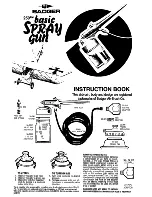
4
© 2001 Wagner Spray Tech. All rights reserved.
English
SELECTING THE PROPER TIP
WIDE ANGLE TIP
The wide angle tip produces a wide pattern that can be adjusted
horizontally or vertically.
To adjust:
1. Make sure the
sprayer is
unplugged.
2. Loosen the wide
angle tip by
turning the tip
counterclockwise
1/4 turn.
3. Turn the
adjusting arm so
that it is pointing down for a horizontal pattern. Turn the
adjusting arm so that it is pointing to the side for a vertical
pattern.
4. Tighten the tip firmly by hand.
ROUND TIP
The round tip produces a round pattern. Use a round tip if the
surface you are spraying is too small for use with the wide angle tip.
The round tip comes in three sizes available at your local
retailer. Use the size that works best for the type of material
you are spraying. The color of the tip center indicates its size:
1.
Blue
(light materials) - .023 inch (0.6mm) opening. This
size works best for oil-based materials.
2.
Pink
(medium materials) - .031 inch (0.8mm) opening. This
all purpose size works best for oil-based materials.
3.
Green
(heavy materials) - .039 inch (1.0mm) opening. This
size works best for hard to spray, coarse materials.
STAIN TIP
The stain tip is an option included with some models. It has a
specially designed opening for use with thin materials such as
thin stains, sealers and waterproofers, and can be adjusted to
reduce overspray. If you did not receive a stain tip and will be
spraying one of these materials, the tip can be purchased at
your local retailer.
The stain tip pattern is round with a fine spray. To adjust the
spray pattern size and coarseness, turn the tip slightly
counterclockwise to narrow the pattern and make the spray
more coarse. Turn the tip slightly clockwise to widen the pattern
and make the spray more fine.
IMPORTANT!
Make sure to tighten all spray tips firmly by hand. If the spray
tip is not tightened firmly enough, the sprayer could leak or
the tip could be damaged. Do not use a tool to tighten the
spray tip. If the tip is too tight, it may be damaged.
SETTING THE POWER CONTROL
Your sprayer offers you four
power levels: 100%, 50%,
25% and 12%. The lower
the power level, the closer
you can get to your work and
the less overspray you will
have. Lower power levels
give you greater control but
require more time to cover an
area.
The sprayer is automatically set to 100% every time you plug it
NOTE: In order to keep an even spray pattern, you will
need to reduce the amount of material flowing
to the gun as you reduce the power level. Turn
the flow knob clockwise slowly to reduce the
material flow.
Horizontal pattern
Vertical pattern
in. To adjust, press the button on the top of the sprayer
once
for 50%,
twice
for 25%, and
three times
12%
Do not get the power level control wet or the sprayer could
be damaged. Be careful during use and cleanup.
FLOW CONTROL KNOB
The spray pattern is controlled by the flow control knob on the
back of the sprayer, and by the thickness of the material being
sprayed.
Turning the flow knob
counterclockwise
increases the amount
of material flow. Turning the flow knob
clockwise
decreases
the amount of material flow. To adjust the pattern:
1. Turn the flow knob fully
counterclockwise
to maximum.
2. Squeeze the trigger and test the
pattern on a piece of scrap wood
or cardboard.
3. Turn the flow knob
clockwise
until
you have a good spray pattern.
• A poor spray pattern will
concentrate the paint in the center
of the spray and go on blotchy.
• A good spray pattern has an even amount of material
throughout the pattern in a fine spray and will go on smoothly.
MATERIAL THINNING
Always test spraying without thinning the material. Thin as
required to achieve optimum spraying performance (refer to #3,
FLOW CONTROL KNOB).
NOTE: If you are spraying with a material that needs
to be thinned, make sure to follow the
manufacturer’s recommendations.
NOTE: Always practice spraying on a piece of scrap
wood or cardboard to test your spray pattern.
Use the coverage rate recommended by the
material’s manufacturer.
NOTE: If you adjust the flow knob and still cannot get
a good pattern, you may need to thin the
material you are using.
Good spray pattern
Poor spray pattern
INCREASE
INCREAS
E
CAUTION
NOTE: Always test the spray pattern on a piece of
scrap wood or cardboard before using the
sprayer.





































